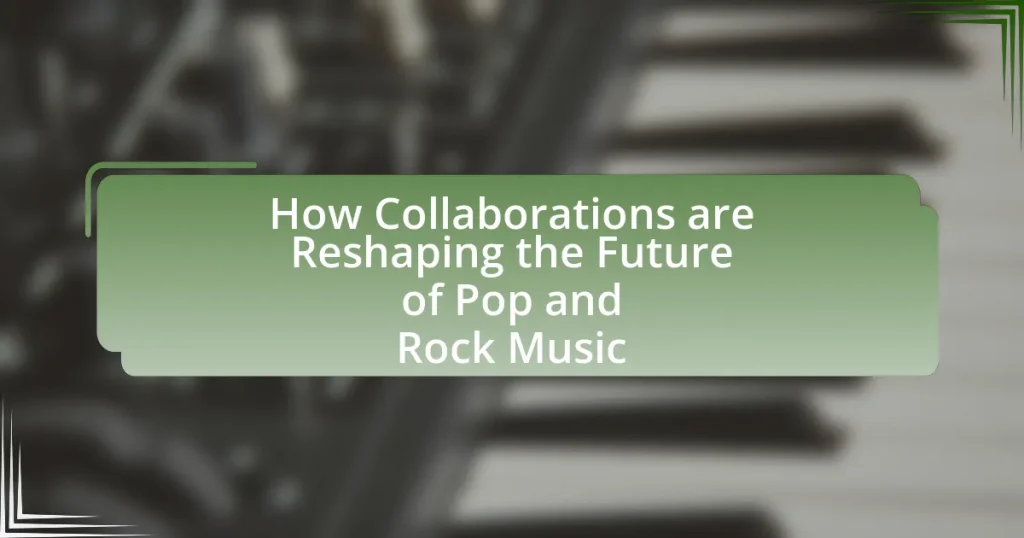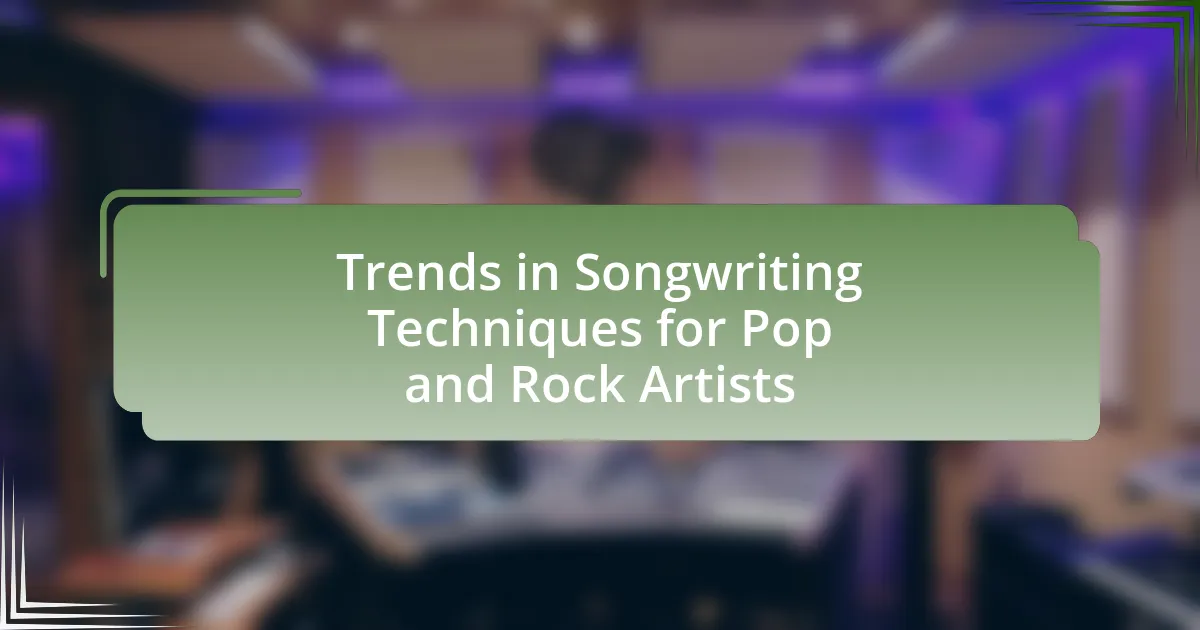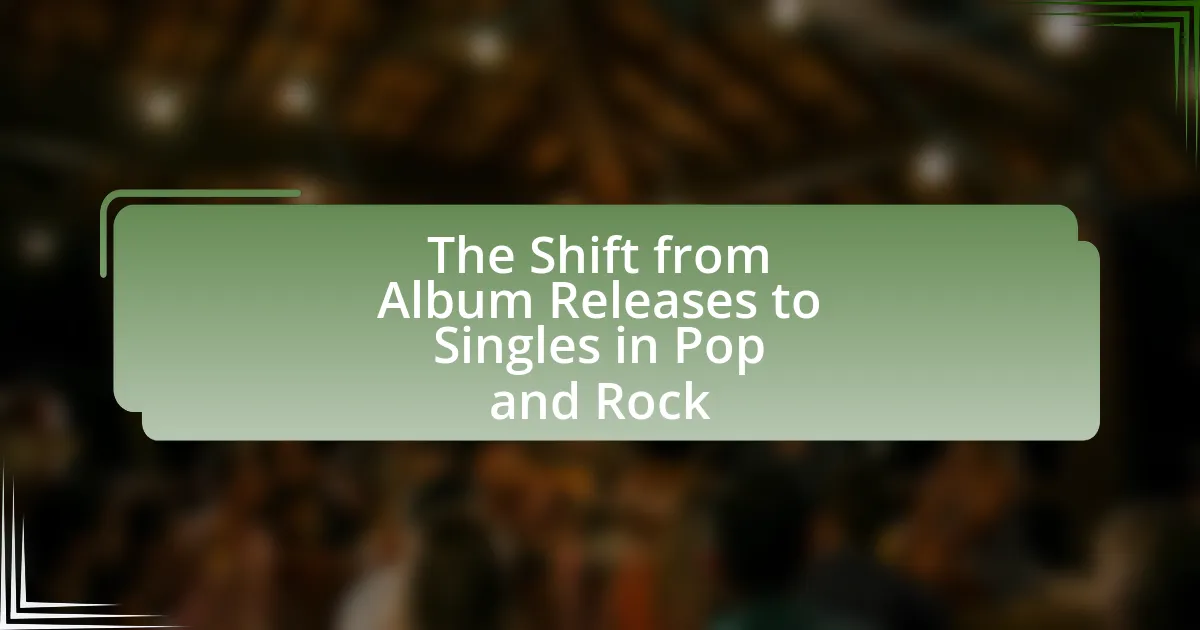Collaborations are reshaping the future of pop and rock music by blending diverse musical styles and expanding audience reach. This article examines the key factors driving these collaborations, including genre blending, technological advancements, and the role of social media in promoting partnerships. It highlights how collaborations enhance creativity, lead to commercial success, and influence the production and distribution of music. Additionally, the article addresses the challenges artists face during collaborations and outlines strategies for maximizing their benefits, ensuring fair credit distribution, and avoiding common pitfalls. Overall, it provides insights into the evolving dynamics of music collaborations and their impact on the industry.
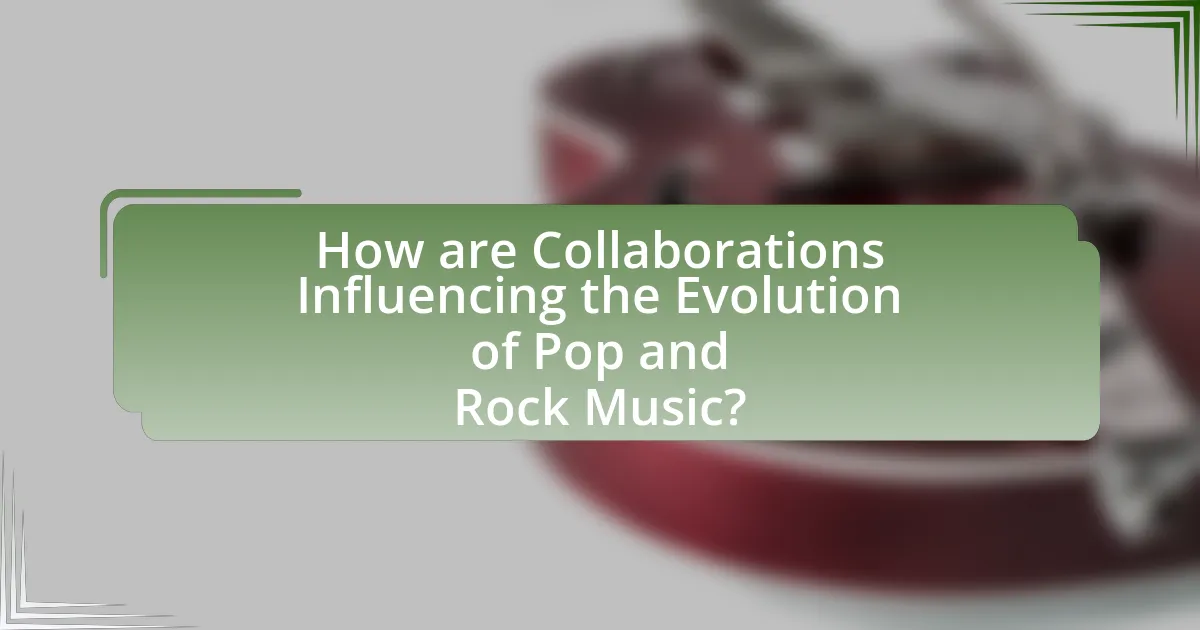
How are Collaborations Influencing the Evolution of Pop and Rock Music?
Collaborations are significantly influencing the evolution of pop and rock music by blending diverse musical styles and expanding audience reach. For instance, the partnership between artists from different genres, such as the collaboration between Billie Eilish and Khalid on “Lovely,” showcases how cross-genre collaborations can create innovative sounds that attract a wider demographic. Additionally, collaborations often lead to increased streaming numbers and chart success; for example, the song “Señorita” by Shawn Mendes and Camila Cabello topped the Billboard Hot 100, demonstrating the commercial viability of such partnerships. This trend reflects a broader shift in the music industry towards inclusivity and experimentation, as artists seek to redefine traditional boundaries and engage with fans in new ways.
What are the key factors driving collaborations in the music industry?
Key factors driving collaborations in the music industry include the desire for genre blending, increased audience reach, and the influence of digital platforms. Genre blending allows artists to experiment and create innovative sounds that attract diverse listeners. Collaborations expand audience reach by combining fan bases, which can lead to higher streaming numbers and ticket sales. Additionally, digital platforms like social media and streaming services facilitate these partnerships by providing easy access to a global audience, as evidenced by the success of collaborative tracks that often trend on platforms like Spotify and YouTube.
How do technological advancements facilitate musical collaborations?
Technological advancements facilitate musical collaborations by enabling artists to connect and create music remotely through digital platforms and tools. These advancements include software for music production, cloud storage for sharing files, and communication apps that allow real-time collaboration regardless of geographical barriers. For instance, platforms like Soundtrap and Splice allow musicians to work together on projects from different locations, streamlining the creative process and increasing the diversity of musical influences. Additionally, advancements in audio quality and streaming technology have made it easier for artists to share their work instantly, fostering a collaborative environment that encourages innovation and experimentation in pop and rock music.
What role do social media platforms play in promoting collaborations?
Social media platforms play a crucial role in promoting collaborations by providing artists with a space to connect, share ideas, and engage with their audiences. These platforms facilitate real-time communication and networking opportunities, enabling musicians to discover potential collaborators across geographical boundaries. For instance, platforms like Instagram and TikTok allow artists to showcase their work, leading to increased visibility and the chance to collaborate with others who share similar styles or interests. Additionally, data from a 2021 survey by the International Federation of the Phonographic Industry indicates that 70% of artists use social media to find collaborators, highlighting its effectiveness in fostering partnerships within the music industry.
Why are artists increasingly choosing to collaborate?
Artists are increasingly choosing to collaborate to enhance creativity and reach broader audiences. Collaborations allow artists to blend different styles and ideas, resulting in innovative music that appeals to diverse fan bases. For instance, the rise of genre-blending collaborations, such as those between pop and hip-hop artists, has led to chart-topping hits that attract listeners from multiple genres. Additionally, data from the music industry shows that collaborative tracks often achieve higher streaming numbers and sales, indicating a commercial advantage. This trend reflects a strategic approach to music-making in an evolving industry landscape.
What benefits do artists gain from collaborating with others?
Artists gain several benefits from collaborating with others, including enhanced creativity, access to new audiences, and the sharing of resources and skills. Collaborations often lead to innovative ideas and diverse artistic expressions, as artists combine their unique perspectives and talents. For instance, a study published in the Journal of Creative Behavior found that collaborative projects can significantly increase the originality of artistic outputs. Additionally, by working with other artists, individuals can tap into each other’s fan bases, thereby expanding their reach and visibility in the music industry. This synergy not only fosters personal growth but also contributes to the evolution of genres, making collaborations a vital aspect of the future of pop and rock music.
How do collaborations enhance creativity and innovation in music?
Collaborations enhance creativity and innovation in music by combining diverse perspectives and skill sets from different artists. This fusion often leads to unique sounds and styles that would not emerge in solo projects. For instance, the collaboration between artists like Jay-Z and Linkin Park on the “Collision Course” album resulted in a groundbreaking blend of hip-hop and rock, showcasing how cross-genre partnerships can push musical boundaries. Additionally, studies indicate that collaborative efforts can stimulate creative thinking, as artists challenge each other’s ideas and inspire new approaches, ultimately leading to innovative compositions and production techniques.
What challenges do artists face when collaborating?
Artists face several challenges when collaborating, including creative differences, communication barriers, and logistical issues. Creative differences can lead to conflicts over artistic direction, as each artist may have distinct visions and styles. Communication barriers often arise from varying levels of experience and differing communication styles, which can hinder effective collaboration. Logistical issues, such as scheduling conflicts and resource allocation, can also complicate the collaboration process. These challenges can impact the overall success of the project and the relationships between the artists involved.
How can differing artistic visions impact collaboration outcomes?
Differing artistic visions can significantly impact collaboration outcomes by creating both challenges and opportunities for innovation. When artists have contrasting perspectives, it can lead to creative friction, which may result in either conflict or a unique fusion of styles that enhances the final product. For instance, a study published in the Journal of Creative Behavior found that diverse artistic inputs often lead to more original and varied outcomes, as artists push each other to explore new ideas and techniques. This dynamic can ultimately enrich the collaborative work, making it more appealing to a broader audience.
What are the potential legal issues surrounding music collaborations?
Potential legal issues surrounding music collaborations include copyright infringement, ownership disputes, and contractual disagreements. Copyright infringement can arise when collaborators use each other’s work without permission, leading to legal action. Ownership disputes often occur regarding the rights to the music created, especially if contributions are not clearly defined in a contract. Additionally, contractual disagreements can stem from misunderstandings about profit sharing, credit attribution, and the scope of each collaborator’s contributions. These issues highlight the importance of clear agreements and communication among collaborators to mitigate legal risks.
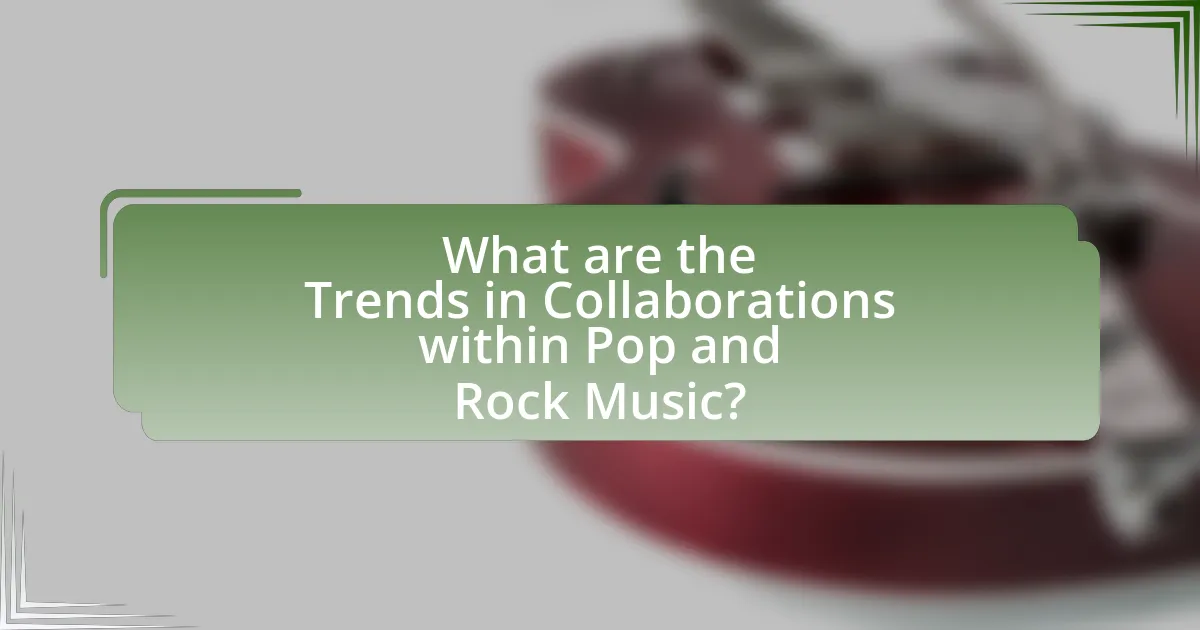
What are the Trends in Collaborations within Pop and Rock Music?
Trends in collaborations within pop and rock music include increased genre-blending, the rise of virtual collaborations, and strategic partnerships between artists and brands. Genre-blending has become prominent as artists from different backgrounds, such as pop and hip-hop, collaborate to create innovative sounds, exemplified by the success of tracks like “Old Town Road” by Lil Nas X featuring Billy Ray Cyrus. Virtual collaborations have surged, especially during the COVID-19 pandemic, with artists utilizing technology to produce music remotely, as seen in projects like “The Lockdown Sessions” by various artists. Additionally, strategic partnerships with brands and influencers have become common, enhancing marketing reach and audience engagement, as demonstrated by collaborations like the partnership between Travis Scott and McDonald’s. These trends indicate a dynamic shift in how artists approach collaboration, reflecting broader changes in the music industry.
How have recent collaborations changed the sound of pop and rock music?
Recent collaborations have significantly diversified the sound of pop and rock music by blending genres and introducing new production techniques. For instance, the partnership between pop artists and hip-hop producers has led to the incorporation of rap elements and electronic beats into traditional rock structures, as seen in tracks like “Old Town Road” by Lil Nas X featuring Billy Ray Cyrus. This fusion not only attracts a wider audience but also encourages experimentation, as artists like Halsey and Machine Gun Kelly have successfully merged pop-punk with contemporary pop, reflecting a shift in musical boundaries. The rise of streaming platforms has facilitated these collaborations, allowing artists to reach global audiences and collaborate across geographical barriers, further enriching the sonic landscape of both genres.
What genres are most commonly blended through collaborations?
The genres most commonly blended through collaborations are pop, rock, hip-hop, and electronic music. These genres frequently intersect due to their broad appeal and the versatility of artists within these styles. For instance, collaborations between pop and hip-hop artists have produced chart-topping hits, such as “Sicko Mode” by Travis Scott featuring Drake, which showcases elements from both genres. Additionally, electronic music often merges with pop, as seen in tracks like “Stay” by Zedd and Alessia Cara, highlighting the trend of genre fusion in contemporary music.
How do collaborations influence the production and distribution of music?
Collaborations significantly enhance the production and distribution of music by combining diverse talents and resources, leading to innovative soundscapes and broader audience reach. When artists collaborate, they often share their fan bases, which can result in increased streaming numbers and sales; for instance, the collaboration between Ed Sheeran and Justin Bieber on “I Don’t Care” achieved over 1 billion streams on Spotify within months of its release. Additionally, collaborations can streamline production processes by pooling expertise and resources, allowing for higher quality recordings and more efficient distribution channels. This trend is evident in the rise of collaborative albums and projects, such as the “Savage Mode” EP by 21 Savage and Metro Boomin, which not only topped charts but also showcased how strategic partnerships can redefine music marketing and accessibility.
What notable collaborations have shaped the current music landscape?
Notable collaborations that have shaped the current music landscape include the partnership between Billie Eilish and Finneas O’Connell, which has produced multiple Grammy-winning albums, and the collaboration between Lil Nas X and Billy Ray Cyrus on “Old Town Road,” which broke records for chart longevity. These collaborations have not only influenced genre blending but also redefined marketing strategies in the music industry, as evidenced by Eilish’s innovative use of social media and Cyrus’s cross-genre appeal.
Which artists have successfully collaborated across genres?
Artists such as Lil Nas X and Billy Ray Cyrus have successfully collaborated across genres, blending country and hip-hop in the hit song “Old Town Road.” This collaboration broke genre barriers and topped the Billboard Hot 100 for a record 19 weeks, demonstrating the commercial viability of cross-genre partnerships. Another notable example is the collaboration between rock band Linkin Park and rapper Jay-Z on the EP “Collision Course,” which fused rock and hip-hop elements, showcasing the potential for diverse musical styles to resonate with a wide audience. These collaborations illustrate how artists can transcend traditional genre boundaries, creating innovative music that appeals to fans from different backgrounds.
How have these collaborations impacted their careers and fan bases?
Collaborations have significantly enhanced the careers and fan bases of artists in pop and rock music by broadening their reach and diversifying their sound. For instance, when artists like Dua Lipa collaborated with Elton John on “Cold Heart,” it not only introduced her to John’s established audience but also showcased her versatility, resulting in increased streaming numbers and chart success. Additionally, collaborations often lead to cross-promotion, where artists tap into each other’s fan bases, as seen with the partnership between Travis Scott and Kid Cudi, which expanded their listener demographics and solidified their positions in the industry. These strategic alliances have proven to be a powerful tool for career growth and fan engagement, evidenced by the rise in social media interactions and concert attendance following such collaborations.
What future trends can we expect in music collaborations?
Future trends in music collaborations will increasingly focus on cross-genre partnerships, driven by the rise of digital platforms and global connectivity. As artists from diverse backgrounds collaborate, they create innovative sounds that blend various musical styles, appealing to wider audiences. For instance, the success of collaborations like Lil Nas X’s “Old Town Road,” which fused country and hip-hop, demonstrates the potential for genre-defying music to capture mainstream attention. Additionally, advancements in technology, such as virtual reality and artificial intelligence, will facilitate remote collaborations, allowing artists to work together regardless of geographical barriers. This trend is supported by the growing number of virtual concerts and online music production tools that enable seamless collaboration across distances.
How might emerging technologies further change collaboration dynamics?
Emerging technologies will further change collaboration dynamics by enabling real-time, remote collaboration through advanced communication tools and platforms. For instance, virtual reality (VR) and augmented reality (AR) can create immersive environments where artists collaborate as if they are in the same physical space, regardless of their actual locations. Additionally, artificial intelligence (AI) can assist in music composition and production, allowing musicians to generate new ideas and refine their work collaboratively. A study by the Berklee College of Music highlights that AI tools are increasingly being used in music creation, leading to innovative collaborative processes that were previously unimaginable. These advancements not only enhance creativity but also democratize access to collaboration, allowing a broader range of artists to participate in the music-making process.
What role will virtual collaborations play in the future of music?
Virtual collaborations will significantly enhance the future of music by enabling artists from diverse geographical locations to create and share their work seamlessly. This shift is driven by advancements in technology, such as high-speed internet and collaborative software, which allow musicians to connect in real-time, regardless of their physical location. For instance, platforms like Splice and Soundtrap facilitate remote collaboration, enabling artists to co-write, produce, and mix tracks together. The rise of virtual collaborations has already been evidenced by successful projects like the 2020 “One World: Together at Home” concert, which featured artists from around the globe performing together virtually, showcasing the potential for global collaboration in music creation.
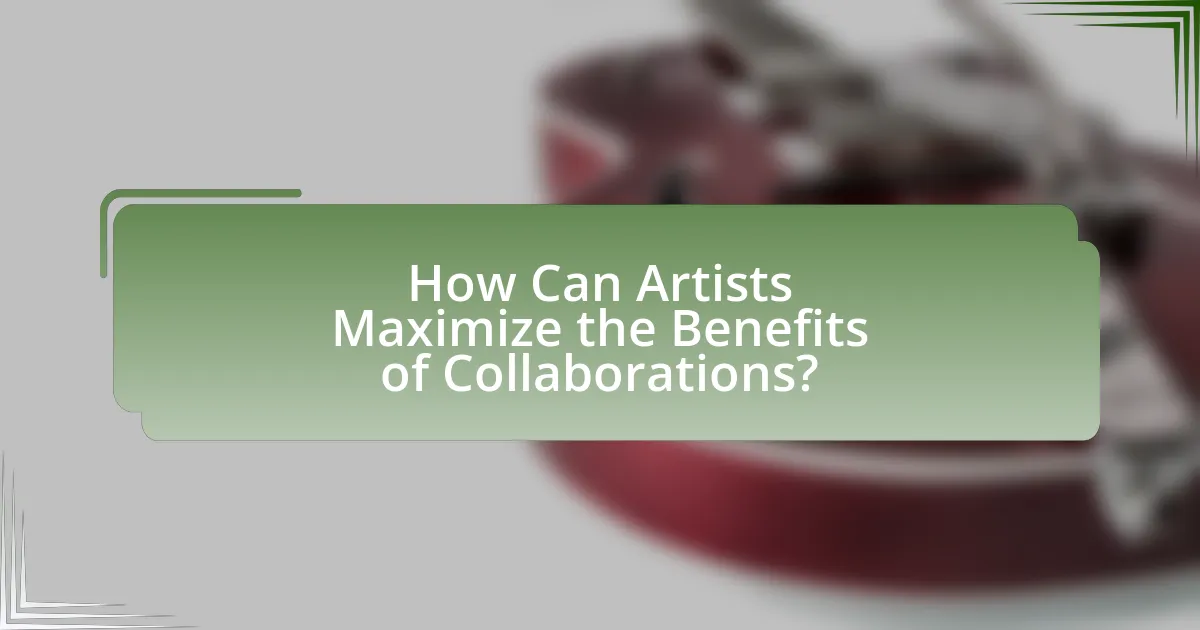
How Can Artists Maximize the Benefits of Collaborations?
Artists can maximize the benefits of collaborations by strategically selecting partners whose strengths complement their own. This approach enhances creativity and broadens audience reach, as evidenced by successful collaborations like the one between Dua Lipa and Elton John, which combined their distinct styles and fan bases, resulting in increased streaming numbers and chart success. Additionally, artists should engage in open communication and shared vision during the collaboration process, ensuring that all parties contribute meaningfully, which fosters innovation and leads to higher-quality outcomes. By leveraging each other’s networks and resources, artists can also tap into new markets, further amplifying their impact in the music industry.
What strategies should artists consider when seeking collaborations?
Artists should consider networking within their genre and beyond to seek collaborations effectively. Building relationships with other musicians, producers, and industry professionals can lead to opportunities for joint projects. Additionally, artists should leverage social media platforms to showcase their work and connect with potential collaborators, as studies indicate that 70% of artists find collaboration opportunities through online interactions. Engaging in collaborative events, such as workshops or festivals, can also enhance visibility and foster partnerships. By actively participating in these environments, artists increase their chances of finding like-minded individuals who share their creative vision.
How can artists identify the right collaborators for their projects?
Artists can identify the right collaborators for their projects by assessing shared artistic vision, complementary skills, and mutual respect. Evaluating past work and artistic styles helps ensure alignment in creative goals. For instance, a study by the University of Southern California found that successful collaborations often stem from artists who have previously demonstrated synergy in their projects, leading to enhanced creativity and innovation. Additionally, networking within industry circles and utilizing platforms like social media can facilitate connections with potential collaborators who share similar values and aesthetics.
What are effective ways to approach potential collaborators?
Effective ways to approach potential collaborators include conducting thorough research on their work and interests, which establishes a foundation for a meaningful connection. Engaging with their content, whether through social media or attending their events, demonstrates genuine interest and can lead to organic conversations. Additionally, presenting a clear and compelling proposal that outlines mutual benefits and shared goals can significantly increase the likelihood of collaboration. According to a study published in the Journal of Business Research, collaborations that emphasize shared values and objectives are more successful, highlighting the importance of alignment in partnership approaches.
What best practices should artists follow during collaborations?
Artists should prioritize clear communication during collaborations to ensure that all parties understand their roles and expectations. Establishing open dialogue fosters trust and creativity, which are essential for successful partnerships. Additionally, artists should define their goals and objectives at the outset, as this alignment helps to streamline the creative process and avoid misunderstandings. Setting boundaries regarding creative input and decision-making can also prevent conflicts and maintain a productive working environment.
Moreover, artists should document agreements and contributions to protect intellectual property and clarify ownership rights, which is crucial in collaborative settings. Research indicates that successful collaborations often involve regular feedback sessions, allowing artists to refine their work collectively and enhance the final product. By adhering to these best practices, artists can maximize the potential of their collaborations and contribute to the evolving landscape of pop and rock music.
How can clear communication enhance collaboration success?
Clear communication enhances collaboration success by ensuring that all team members understand their roles, objectives, and expectations. When artists and producers in pop and rock music communicate clearly, they can align their creative visions, leading to more cohesive and innovative projects. Research shows that effective communication can increase team performance by up to 25%, as it minimizes misunderstandings and fosters a collaborative environment. This alignment not only streamlines the creative process but also enhances the overall quality of the music produced, ultimately contributing to the success of collaborative efforts in the industry.
What methods can be used to ensure a fair distribution of credit and revenue?
To ensure a fair distribution of credit and revenue in music collaborations, transparent agreements and equitable revenue-sharing models are essential. These methods involve clearly defined contracts that specify the roles and contributions of each collaborator, ensuring that all parties understand their rights to credit and financial returns. For instance, the use of split sheets, which document the percentage of ownership for each contributor, can prevent disputes and promote fairness. Additionally, platforms like SoundExchange facilitate equitable revenue distribution by tracking digital performance royalties, ensuring that all artists receive their fair share based on usage data. Such practices are supported by industry standards and legal frameworks that advocate for transparency and fairness in music collaborations.
What common pitfalls should artists avoid in collaborations?
Artists should avoid lack of clear communication in collaborations. Effective communication ensures that all parties understand their roles, expectations, and creative visions, which is crucial for a successful partnership. Misunderstandings can lead to conflicts, dissatisfaction, and ultimately, a failed project. Additionally, artists should steer clear of neglecting contractual agreements, as these documents protect their rights and outline the terms of collaboration. Without clear contracts, disputes over ownership, revenue sharing, and creative control can arise, jeopardizing the collaboration’s success. Lastly, artists must avoid compromising their artistic integrity for the sake of collaboration; maintaining authenticity is essential for resonating with audiences and preserving their unique identities.
How can misunderstandings be minimized in collaborative efforts?
Misunderstandings in collaborative efforts can be minimized through clear communication and defined roles. Establishing open lines of communication ensures that all participants share their ideas and concerns, reducing the likelihood of misinterpretation. Additionally, clearly defining each collaborator’s role and responsibilities helps to set expectations, which can prevent confusion. Research indicates that teams with well-defined roles experience 30% fewer conflicts, as clarity fosters a more cohesive working environment.
What are the signs of a successful collaboration, and how can they be measured?
Signs of a successful collaboration include clear communication, shared goals, mutual respect, and positive outcomes. These elements can be measured through metrics such as project completion rates, stakeholder satisfaction surveys, and the achievement of predefined objectives. For instance, a study by the Project Management Institute found that projects with effective communication are 20% more likely to succeed, highlighting the importance of communication in collaborative efforts. Additionally, tracking the number of successful joint projects and analyzing feedback from participants can provide concrete evidence of collaboration effectiveness.
